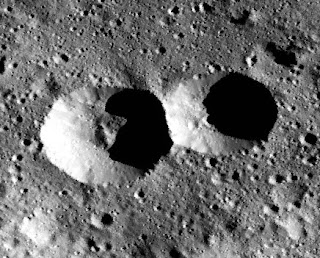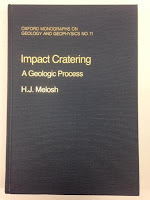More About Secondary Craters
 |
| Figure 1: Copernicus Crater (LROC Image/ASU/NASA) |
Jay Melosh (1989) points out that as the range from the primary crater increases, secondary craters are more dispersed and their shapes are more circular. The improved circularity of distal secondaries results from the projectile's higher velocity, and the highest velocity ejecta is typically going to travel the furthest. The lower density of secondary craters combined with them being more circular, means they look a lot like primary impact craters!
 |
| Figure 2: Secondary craters |
High-energy ejecta have a decent chance of landing close together at the same time, will look like primary impacts, and thus will be difficult to distinguish from real doublet craters.
Figure 1 shows the Lunar crater Copernicus and some of its ejecta rays and secondary craters. A closeup of the area outlined in white appears in Figure 2. This image contains a number of secondary crater chains, potions of which look quite similar to doublets. Figure 3 shows a pair of craters near the bottom of Figure 2 that look very much like a primary doublet crater, including the septum formed between them.
A few interesting observations by Dr. Melosh:
- On the Moon, the largest secondary crater has a diameter of ~4% of the primary crater with which it is associated.
- Comparing Lunar secondary craters to those on Mercury, which has twice the gravity of the Moon:
- Mercury secondary crater ranges from the primary are half that of the Moon
- Mercury secondary crater densities are 4 times that of the Moon
- A small quantity of solid material from the near surface, ejected by stress-wave interference, can be ejected at very high speed, possibly higher than the escape velocity of the target body.
 |
| Figure 3: A doublet crater? (no) |
On Ceres, which has a much lower escape velocity than the Moon (about 500 meters/second), this should place a relatively low upper bound on the impact velocity for secondary craters.
I hope this will allow me to use circularity ratio and form ratio analysis to discriminate between primary and secondary impacts on Ceres (the craters with irregular rims, i.e., the ones that are less circular, should be secondaries).
NOTE: JMARS was used to create the figures in this post.
References:
- Melosh, H. J. (1989). Impact cratering: A geologic process. Research supported by NASA. New York, Oxford University Press (Oxford Monographs on Geology and Geophysics, No. 11), 1989, 253 p., 11.


Online slot machines in the desert - Shootercasino
ReplyDeleteThe desert sands casino offers a full 샌즈카지노 range of slot machines from popular casino games such as 다파벳 Mega Millions and leovegas LuckyLand Slots. With a full suite of slots,
Therefore, developing an efficient technique for synthesizing 3D mesoporous graphene with a excessive contact space for high-energy-density EDLCs remains a major problem. Join over 240,000 designers who stay up-to-date with the Core77 newsletter. Do you want to receive our free Eurasia Review newsletter for free? It’s easy, simply clickhere to have Eurasia Review’s newsletterdelivered via RSS, as an email newsletter, via cellular or on your personal news Healthrite Cloud Nine Slippers page.
ReplyDelete